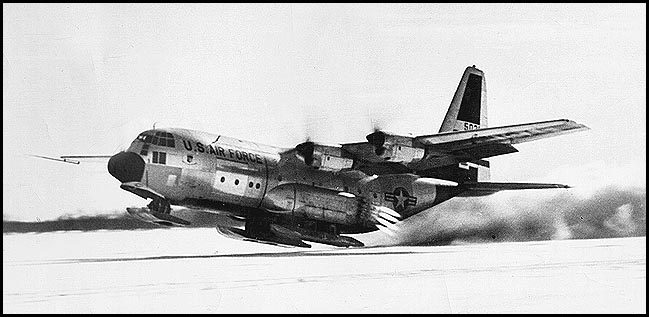DEVELOPMENT OF THE
LOCKHEED HERCULES C-130D
Due to the fact that the marginal zone of the Greenland Ice Cap blocked surface transportation, the obvious way to build and resupply DEW line DYE sites was airlift. The concept had been proved during Project Snowman and other expeditions and later been re-affirmed on a practical basis in the resupply of N-33 and N-34. However, because the planned construction of the two DYE sites on the Greenland Ice Cap would involve airlift of material and equipment which was beyond the capability of the ski-wheel aircraft then in the Air Force inventory, an aircraft with a larger cargo capability and longer range was required. Fortunately, the means were available. During 1957, the Air Force conducted extensive testing of a ski-wheel configured C-130A (55-0021) which could be operated from both conventional runways and snow or ice covered surfaces. The tests proved the Lockheed manufactured aircraft could successfully do what had already been done by other ski-wheeled aircraft. (47)...(Excerpt, Cloe, p. 18)...
Although the C-123J was an improvement over the C-47, it still lacked the necessary range and load capacity required for the Greenland Ice Cap. A larger aircraft was needed. This led to the modification of C-130A, 55-0021, in 1956. The aircraft made its first flight in January 1957 from Dobbins AFB, near the Lockheed-Georgia plant at Marietta, Georgia. (53) It was later tested extensively by a joint Air Force-Lockheed team at Bemidji during Project Slide (snow, land, ice, development) ...(Excerpt, Cloe, p. 19)...

|
Photo courtesy of Gerry Harris, Firebird Navigator |
||
|
Prototype C-130D, Tail Number 50-021, departing frozen lake near Bemidji, Minnesota during Project Slide tests. |
||
Following the successful conclusion of the test, the Air Force requested Lockheed to modify twelve of its C-130As (57-0484 through 57-0495) to C-130Ds. The modified aircraft were delivered to the Air Force on the following dates: (55)...(Excerpt, Cloe, p. 21)...
Lockheed Hercules C-130D Acceptance Dates:
|
57-0484 |
--------------- |
02 Feb 59 |
|
|
57-0485 |
--------------- |
22 Apr 59 |
|
|
57-0486 |
--------------- |
23 Apr 59 |
|
|
57-0487 |
--------------- |
27 Feb 59 |
|
|
57-0488 |
--------------- |
17 Mar 59 |
|
|
57-0489 |
--------------- |
05 Feb 59 |
|
|
57-0490 |
--------------- |
19 Mar 59 |
|
|
57-0491 |
--------------- |
02 Apr 59 |
|
|
57-0492 |
--------------- |
24 Apr 59 |
|
|
57-0493 |
--------------- |
02 Apr 59 |
|
|
57-0494 |
--------------- |
20 Apr 59 |
|
|
57-0495 |
--------------- |
27 Apr 59 |
|
The C-130Ds were the only ski-wheel equipped C-130s built for the Air Force. They were, and still are, the largest aircraft to be equipped with skis. The modification involved installation of a nose and two main skis fitted around conventional landing gear. The nose ski measured 10 feet long by 5 feet 6 inches wide. The main skis were 20 feet long by 5 feet 6 inches wide. They had an 8 degree nose-up and 15 degree nose down pitch to enable them to follow uneven surfaces. The undersides were coated with Teflon to reduce surface friction and resist adhesion to ice and snow. The installations and their associated hydraulic systems causes some unique maintenance problems. One problem caused normal time to change a tire to be increased from 45 minutes to 10 hours. (57) Because of the long distances the aircraft was expected to fly, two 450-gallon underwing pylon fuel tanks were installed, and provisions were made for two 500-gallon cargo compartment tanks. (58) Later, in 1966, two 450-gallon tanks were installed in the inboard wing dry-bay area. (59)...(Excerpt, Cloe, p. 21)
The Air Force's belief in the C-130D was confirmed when it was later compared with the C-123J. While the C-123J could carry a maximum load of 9,820 pounds and fly 772 nautical miles and return, the C-130D could carry the same load 1,240 nautical miles and return. In addition, its cruise speed was considerable higher. (60)...(Excerpt, Cloe, p. 21)...
The two Ice Cap DYE sites were completely dependent on airlift for their resupply as well as their original construction. Shortly after the US-Danish agreement authorizing construction of the Greenland DYE site was signed, the US Corps of Engineers awarded the contracts for the procurement of materials conformed to the standards throughout the DEW line. However, with the Ice Cap it was a different story. No single item could exceed 9 by 9 by 41 feet in size and length and weigh no more than 15 tons - the limitations of the C-130D. (71)...(Excerpt, Cloe, p. 27)....
![]()
An Official Air Force Historical Monograph:
Cloe, John Haile, "C-130D Support of the Greenland Ice Cap Dye Sites," Elmendorf AFB, Alaska, January 1978.